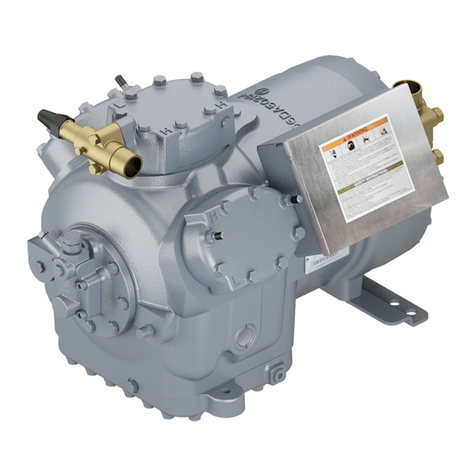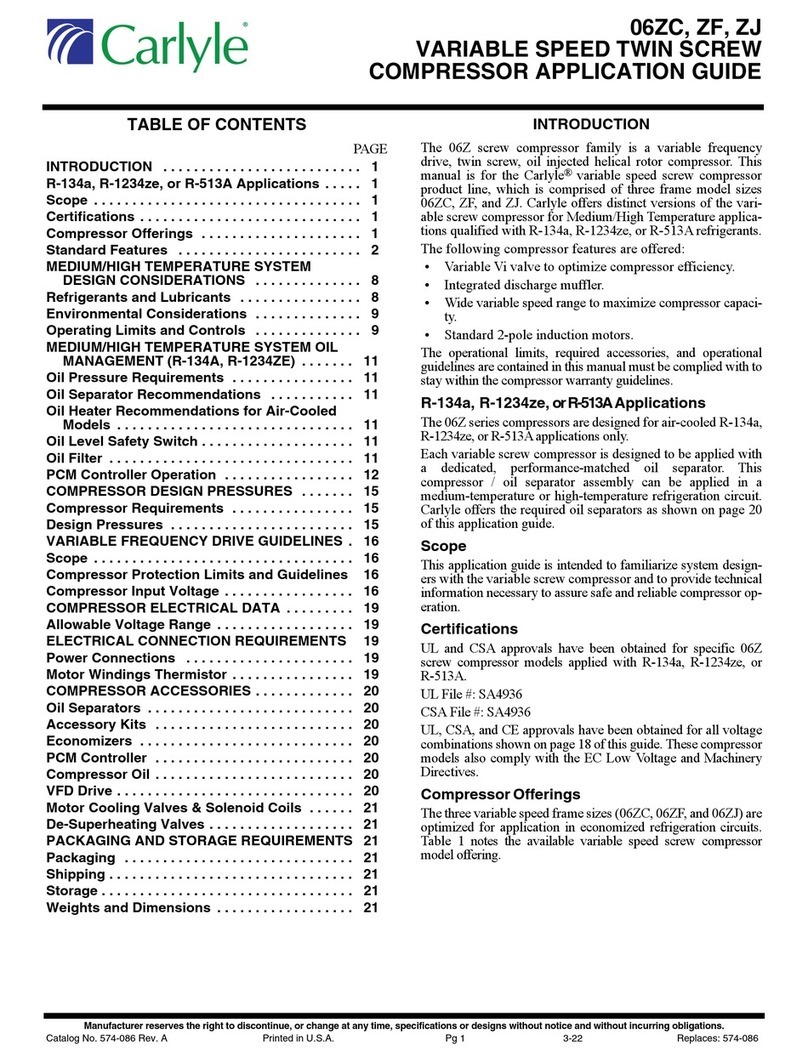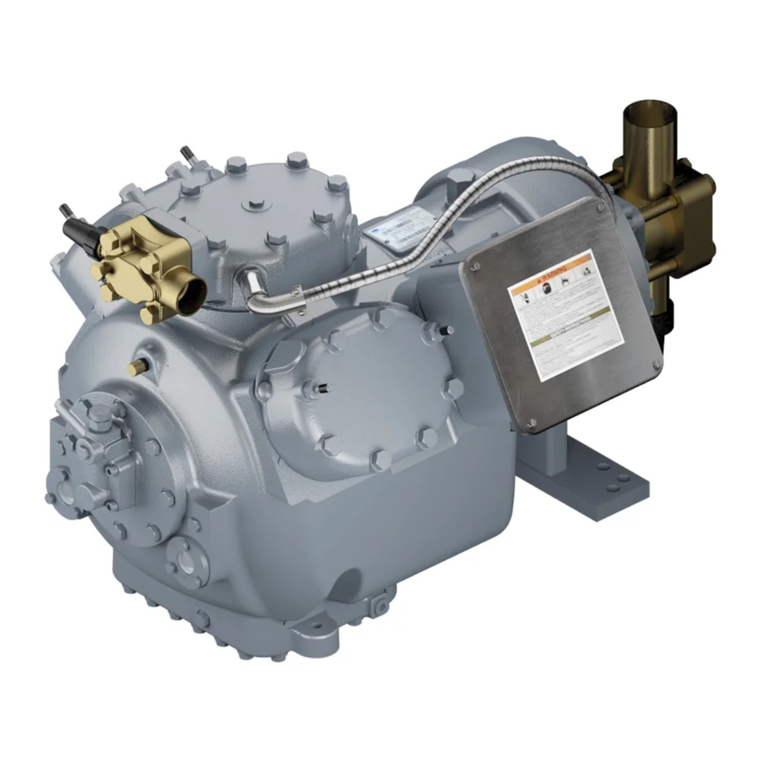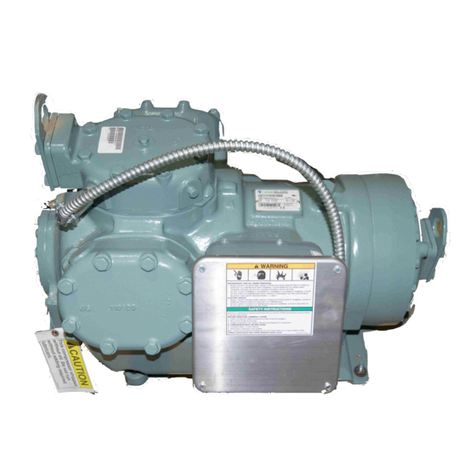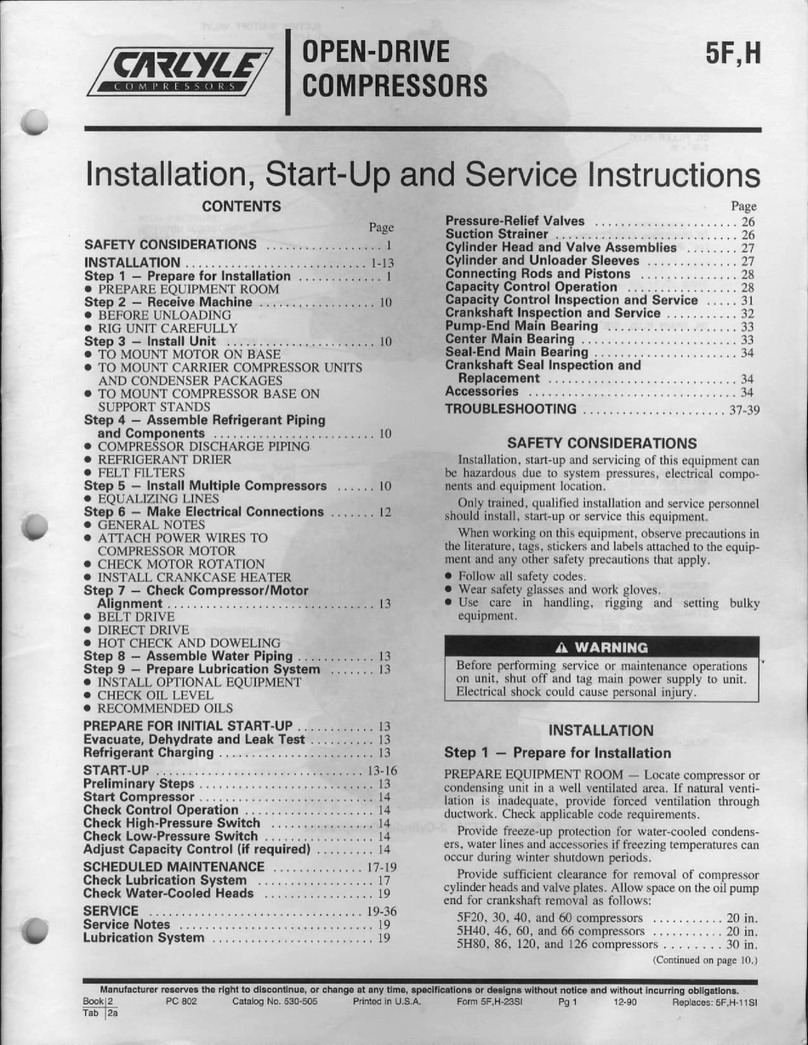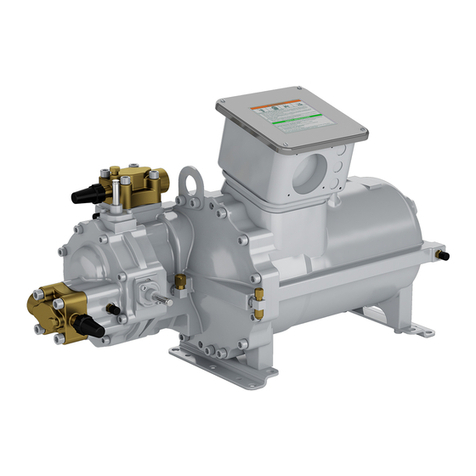
3
This manual is for the Carlyle®Paragon screw compres-
sor product line, which is comprised of four unique com-
pressor families (series type TS, TT, TU, and TV). Carlyle
offers distinct versions of the Paragon Twin-Screw Com-
pressors for Low/Medium/High Temperature applications.
The operational limits, required accessories, and opera-
tional guidelines are contained in this manual and must
be complied with to stay within the compressor warranty
guidelines.
R-134a, R-513A, R-1234ze Applications
The TS series compressors are designed for air-cooled
applications only. The TT, TU, and TV series compres-
sors are available in both air-cooled and water-cooled
applications. There are 3 different displacement sizes of
each of the TS, TT, and TV series compressors, along
with 2 displacement sizes of the TU series compressor.
Each Paragon twin-screw compressor is designed to be
applied with a dedicated, performance-matched oil sep-
arator. Carlyle offers two types of oil separators: high-effi-
ciency (for applications in flooded-type systems) and
standard-efficiency (for application in direct expansion-
type systems). This compressor / oil separator assembly
is then applied in a single-compressor, medium-tempera-
ture, or high-temperature refrigeration circuit. Carlyle
offers the required oil separators as shown in Section 9.1
of this application guide. See Section 10.5 of this docu-
ment for Assembly views of the R-134a Paragon models
applied with these oil separator designs. Application
guidelines for the R-134a compressors that have been
approved for VFD applications are covered in this guide.
R-404A, R-407A, R-407C, R-407F, R-448A,
R-449A, and R-507A Applications
The low/medium temperature Paragon twin-screw com-
pressor models are designed to be applied in single or
multiple compressor circuits. Each circuit requires a prop-
erly selected oil separator (contact Carlyle Application
Engineering for selection criteria). Carlyle offers 3 models
within each of the TS and TT compressor series for low/
medium temperature applications.
Scope
This application guide is intended to familiarize system
designers with the Paragon screw compressor and to
provide technical information necessary to assure safe
and reliable compressor operation.
Certifications
UL and CSA approvals have been obtained for specific
06TS, 06TT, 06TU, and 06TV screw compressor models
applied with R-134a and for certain 06TS and 06TT
screw compressor models applied with R-404A, R-407A,
R-407C, R-407F, and R-507A (compressors that have an
R or M in the fifth digit of the model number).
UL File #: SA4936 CSA File #: SA4936
For the UL and CSA approvals it is essential that only
Listed, Special-Purpose circuit breakers or Carlyle
approved, solid-state motor overloads be used (contact
Carlyle Application Engineering for further information).
For circuit breakers, the Must Trip Amp settings must not
exceed 140% of the compressor rated load amps.
Both UL and CSA approvals have been obtained for all
voltage combinations shown in Section 8.3 of this guide.
These compressor models also comply with the EC Low
Voltage and Machinery Directives.
Compressor Offerings
The four Paragon compressor frame sizes (TS, TT, TU,
and TV) are optimized for application in economized
refrigeration circuits. Non-economized capacity will
decrease by 11 to 16% for water-cooled operation. The
following tables show the displacements for each of the
compressors at 60 Hz.
Compressor Displacement (R-134a, R-513A,
R-1234ze for air and water cooled models)
See Tables 1 and 2.
Table 1 — Air-Cooled Models
Table 2 — Water-Cooled Models
NOTE: Carlyle has optimized the Vi (volume index) for
the R-134a air-cooled and water-cooled models.
MODEL
NUMBER
NOMINAL
HORSEPOWER
DISPLACEMENT
(CFM at 60 Hz)
06TSA137 60 137
06TSA155 75 155
06TSA186 75 186
06TTA266 120 266
06TTA301 150 301
06TTA356 150 356
06TUA483 225 483
06TUA554 225 554
06TVA680 340 680
06TVA753 340 753
06TVA819 340 819
MODEL
NUMBER
NOMINAL
HORSEPOWER
DISPLACEMENT
(CFM at 60 Hz)
06TTW266 90 266
06TTW301 90 301
06TTW356 120 356
06TUW483 160 483
06TUW554 160 554
06TVW680 225 680
06TVW753 225 753
06TVW819 225 819
Introduction
